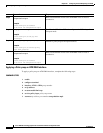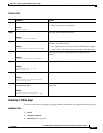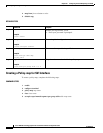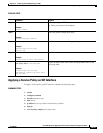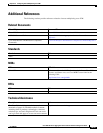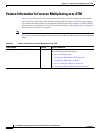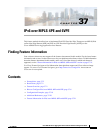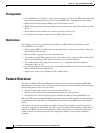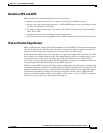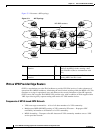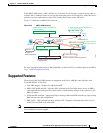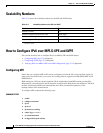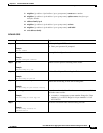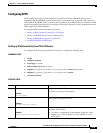
37-2
Cisco ASR 901 Series Aggregation Services Router Software Configuration Guide
OL-23826-09
Chapter37 IPv6 over MPLS: 6PE and 6VPE
Feature Overview
Prerequisites
• Cisco IOS Release 15.2(2)SNI or a later release that supports the IPv6 over MPLS: 6PE and 6VPE
feature must be installed previously on the Cisco ASR 901 Series Aggregation Services Router.
• Multiprotocol Label Switching (MPLS) in provider backbone devices.
• MPLS with Virtual Private Network (VPN) code in provider devices with VPN provider edge (PE)
devices.
• Border Gateway Protocol (BGP) in all devices providing a VPN service.
• Cisco Express Forwarding switching in every MPLS-enabled device.
Restrictions
The following restrictions are applicable for the IPv6 over MPLS: 6PE and 6VPE feature on the
Cisco IOS Release 15.2(2)SNI.
• All the existing MPLS and IPv6 restrictions are applicable, as the base infrastructure of IPv6 and
IPv4 MPLS remains the same.
• 6PE and 6VPE is supported only on the SVI interfaces.
• The number of global VRFs supported is the same as that of IPv4, as both the IPv4 and IPv6 VPN
Routing and Forwarding (VRF) share the resources from the global VRF pool.
• The number of IPv6 VRFs supported is restricted to 113, though the maximum number of
configurable VRFs are 127.
• For the single label per prefix mode allocation, the 6PE and 6VPE scale is limited by the number of
labels available in the box (4000 labels).
• Supports only static routes and BGP for IPv6 in VRF context.
Feature Overview
The IPv6 over MPLS: 6PE and 6VPE feature enables the service providers running an MPLS/IPv4
infrastructure to offer IPv6 services without any major changes in the infrastructure. This feature offers
the following options to the service providers:
• Connect to other IPv6 networks accessible across the MPLS core
• Provide access to IPv6 services and resources that service provider provides
• Provide IPv6 VPN services without going for complete overhaul of existing MPLS/IPv4 core
6PE and 6VPE uses the existing MPLS/IPv4 core infrastructure for IPv6 transport. It enables IPv6 sites
to communicate with each other over an MPLS/IPv4 core network using MPLS label switched paths
(LSPs).
This feature relies heavily on multiprotocol Border Gateway Protocol (BGP) extensions in the IPv4
network configuration on the provider edge (PE) router to exchange IPv6 reachability information (in
addition to an MPLS label) for each IPv6 address prefix. Edge routers are configured as dual-stack,
running both IPv4 and IPv6, and use the IPv4 mapped IPv6 address for IPv6 prefix reachability
exchange.



